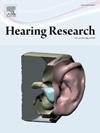Hemispheric difference of adaptation lifetime in human auditory cortex measured with MEG
IF 2.5
2区 医学
Q1 AUDIOLOGY & SPEECH-LANGUAGE PATHOLOGY
引用次数: 0
Abstract
Adaptation is the attenuation of a neuronal response when a stimulus is repeatedly presented. The phenomenon has been linked to sensory memory, but its exact neuronal mechanisms are under debate. One defining feature of adaptation is its lifetime, that is, the timespan over which the attenuating effect of previous stimulation persists. This can be revealed by varying the stimulus-onset interval (SOI) of the repeated stimulus. As SOI is increased, the peak amplitude of the response grows before saturating at large SOIs. The rate of this growth can be quantified and used as an estimate of adaptation lifetime. Here, we studied whether adaptation lifetime varies across the left and the right auditory cortex of the human brain. Event-related fields of whole-head magnetoencephalograms (MEG) were measured in 14 subjects during binaural presentation of pure tone stimuli. To make statistical inferences on the single-subject level, additional event-related fields were generated by resampling the original single-trial data via bootstrapping. For each hemisphere and SOI, the peak amplitude of the N1m response was then derived from both original and bootstrap-based data sets. Finally, the N1m-peak amplitudes were used for deriving subject- and hemisphere-specific estimates of adaptation lifetime. Comparing subject-specific adaptation lifetime across hemispheres, we found a significant difference, with longer adaptation lifetimes in the left than in the right auditory cortex (p = 0.004). This difference might have a functional relevance in the context of temporal binding of auditory stimuli, leading to larger integration time windows in the left than in the right hemisphere.
求助全文
约1分钟内获得全文
求助全文
来源期刊

Hearing Research
医学-耳鼻喉科学
CiteScore
5.30
自引率
14.30%
发文量
163
审稿时长
75 days
期刊介绍:
The aim of the journal is to provide a forum for papers concerned with basic peripheral and central auditory mechanisms. Emphasis is on experimental and clinical studies, but theoretical and methodological papers will also be considered. The journal publishes original research papers, review and mini- review articles, rapid communications, method/protocol and perspective articles.
Papers submitted should deal with auditory anatomy, physiology, psychophysics, imaging, modeling and behavioural studies in animals and humans, as well as hearing aids and cochlear implants. Papers dealing with the vestibular system are also considered for publication. Papers on comparative aspects of hearing and on effects of drugs and environmental contaminants on hearing function will also be considered. Clinical papers will be accepted when they contribute to the understanding of normal and pathological hearing functions.
 求助内容:
求助内容: 应助结果提醒方式:
应助结果提醒方式:


